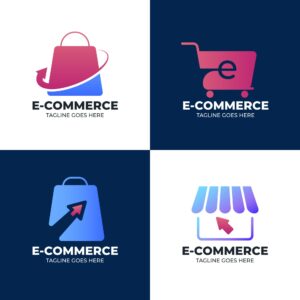
Table of Contents
What is eCommerce Marketing?
Ecommerce marketing is the process of promoting and selling products or services through an online platform, such as a website or app. This can include a variety of tactics, such as search engine optimization, social media advertising, email marketing, and content marketing. In this article, you will learn the most crucial and results-driven ecommerce marketing strategies.

The goal of ecommerce marketing is to drive traffic to the website, convert visitors into customers, and retain those customers through repeat business. To be successful in eCommerce marketing, it is important to have a clear understanding of your target audience, the products or services you offer, and the channels you will use to reach and engage potential customers.
Best Ecommerce Marketing Strategies
Here are six ecommerce marketing strategies and tips to help you effectively promote your online store and drive sales:
1. eCommerce Branding

commerce branding is the most essential and effective ecommerce marketing strategy. The stronger will be your brand reputation, the more effective would be marketing results. Creating brand identity and awareness is very crucial for long-term success in any business. As a eCommerce business owner, you should work on marketing your brand name. How to create eCommerce branding? Here are the small tips that would help you in creating your brand identity.
Define your brand values
Your brand values and personality should reflect the essence of your business and what you stand for. These elements should be reflected in your branding, messaging, and marketing materials.
Develop a unique visual identity
Your visual identity should include a logo, color palette, typography, and imagery that are consistent across all channels and touchpoints. A strong visual identity can help you stand out in a crowded market and make a lasting impression on customers.
Create a compelling brand story
A brand story is a narrative that tells the history, purpose, and values of your brand. It helps customers understand what your brand is all about and why they should choose you over the competition.
Provide excellent customer service
Providing excellent customer service is an important part of building a strong brand. This includes responding promptly to customer inquiries and complaints and going above and beyond to ensure customer satisfaction.
Consistently deliver high-quality products and services
Consistently delivering high-quality products and services is crucial for building a strong brand. This includes ensuring that your products meet customer expectations and are backed by a solid return policy.
Engage with your audience
Building a relationship with your customers is an important part of building a strong brand. Engage with your audience through social media, email marketing, and other channels to build a loyal following.
Stay true to your brand
It’s essential to remain consistent with your brand messaging and visual identity across all channels and touchpoints. This helps to build trust with your customers and establishes your brand as a reliable and trustworthy choice.
2. eCommerce Content Marketing
![]()
Content marketing is a strategy that involves creating and sharing valuable, relevant, and consistent content with the goal of attracting and retaining a clearly defined audience. In the context of e-commerce, content marketing can be an effective way to attract and engage potential customers and drive sales.
Here are a few ways e-commerce businesses can use content marketing to their advantage:
Blogging
Blogging can help e-commerce businesses attract and engage potential customers by providing valuable information, tips, and resources related to the products or services they offer. Blogs can also help businesses establish their brand as a thought leader in their industry and improve their search engine rankings.
Video Marketing
Video marketing can be a powerful tool for e-commerce businesses to showcase their products and tell their brand’s story. By creating engaging and informative video content, businesses can attract and engage potential customers and drive sales.
Overall, content marketing is a crucial part of any e-commerce marketing strategy and can help businesses attract and retain customers, build their brand, and drive sales.
3. Utilize search engine optimization (SEO)
SEO is the process of optimizing your online store’s content and structure to make it more easily discoverable by search engines like Google. By optimizing your store for relevant keywords, you can improve its visibility in search results and attract more qualified traffic. Some tips for improving your store’s SEO include:
- Conduct keyword research to identify the terms and phrases your target audience is using to search for products like yours
- Use those keywords in your product titles, descriptions, and other relevant page content
- Ensure your website is mobile-friendly and loads quickly
- Use header tags and alt tags to signal to search engines what your content is about
- Use internal and external links to improve the credibility and authority of your website
4. Run Influencer Marketing Campaigns

Influencer marketing is a type of marketing strategy in which brands partner with individuals who have a strong online presence and a large following on social media or other platforms. These individuals, known as influencers, have the ability to reach a large audience and promote products or services to their followers.
Here are some steps to consider when planning an influencer marketing campaign for an e-commerce business:
Define your goals
What do you want to achieve with your influencer marketing campaign? Do you want to increase brand awareness, drive sales, or engage with a specific audience?
Identify your target audience
Who is your target audience and which influencers have a following that aligns with this audience? Research influencers in your industry or niche and consider their engagement rates, the quality of their content, and their audience demographics.
Choose your influencers
Once you have a list of potential influencers, reach out to them and ask if they are interested in collaborating with your brand. Be sure to clearly communicate your goals and the terms of the collaboration.
Create a content plan
Work with your influencers to create a content plan that aligns with your brand and resonates with their audience. This could include sponsored posts, giveaways, or other forms of content.
Measure and analyze the results
Use tools such as Google Analytics or social media analytics to track the performance of your campaign and measure its success. Use this information to optimize your future campaigns and improve the ROI of your influencer marketing efforts.
It’s important to note that influencer marketing can be a powerful tool for e-commerce businesses, but it’s not a one-size-fits-all solution. It’s important to carefully plan and execute your campaigns to ensure that they are successful and achieve your desired results.
5. Leverage social media

Social media platforms like Facebook, Instagram, and Twitter can be powerful marketing tools for eCommerce businesses. Social media is the biggest pillar of e-commerce marketing. Almost, 95% ecommerce businesses run social media campaigns. It is the most popular of all ecommerce marketing strategies. You can use social media marketing to engage with your audience, share updates and special offers, and showcase your products. Some tips for using social media for eCommerce marketing include:
- Identify the social media platforms where your target audience is most active
- Post regular updates and engage with your followers by responding to comments and messages
- Use hashtags and participate in relevant Twitter chats and Instagram challenges
- Utilize paid advertising on social media to target specific demographics and interests
- Use social media influencer marketing to reach new audiences and build credibility
These ecommerce marketing tips help you attract more customers on social media .
6. Integrate TikTok Marketing Strategy

TikTok is a social media platform that allows users to create and share short videos with music, effects, and other content. It has become popular with users and businesses alike for its potential as a marketing tool, particularly for ecommerce. Here are a few ways that businesses can use TikTok for ecommerce marketing:
Create engaging content
TikTok is all about creative and entertaining content, so it’s important to think about how your business can create videos that will grab users’ attention. This could include showcasing your products in a fun and creative way, or using TikTok’s features like music, effects, and filters to add interest to your videos.
Use hashtags
TikTok allows users to tag their videos with relevant hashtags, which makes it easier for users to find and discover content. By using relevant hashtags, you can increase the visibility of your TikTok content and reach a wider audience.
Collaborate with influencers
TikTok is home to a large and active community of influencers, who have the ability to reach a large and engaged audience. By collaborating with influencers on TikTok, you can tap into their followings and potentially reach a larger audience for your business.
Utilize TikTok’s e-commerce features
TikTok has a number of features that are specifically designed for e-commerce. For example, the “Shop Now” button allows users to directly link to your online store from your TikTok profile. You can also use the “Product Catalog” feature to showcase your products and allow users to easily browse and purchase items.
Overall, TikTok can be a powerful tool for e-commerce marketing, but it’s important to create engaging and creative content that resonates with users and effectively promotes your products or services.
7. Upselling Products on your eCommerce Store

You should offer product upsells on your eCommerce store. Here are some tips for upselling products on an e-commerce store:
Offer related products
When a customer is viewing a product, consider displaying related products that complement the item they are viewing. For example, if a customer is viewing a laptop, you could show them a mouse, a laptop case, or a warranty.
Use scarcity or urgency
Create a sense of urgency by highlighting limited stock or limited-time offers. This can encourage customers to purchase additional items or upgrade to a higher-priced option.
Use social proof
Showing customer reviews or ratings can help increase trust in your products and encourage customers to purchase additional items.
Offer bundle deals
Consider offering bundle deals that include multiple products at a discounted price. This can be a great way to encourage customers to purchase more items.
Upsell at checkout
At the checkout page, consider offering additional related products or higher-priced options.
Personalize the upsell
Use customer data and personalization tools to tailor the upsell to each individual customer. For example, if a customer has purchased a camera, you could suggest additional camera lenses or accessories based on the type of camera they purchased.
Provide value
Make sure that the products you are upselling provide value to the customer. If the products are not perceived as valuable, customers may be less likely to purchase them.
Overall, the key to successful upselling is to focus on providing value to the customer and building trust in your brand. By offering related products, creating a sense of urgency, using social proof, and personalizing the upsell, you can increase the chances of making additional sales.
8. Use Instagram for eCommerce Marketing
![]()
Instagram can be a powerful platform for eCommerce marketing, as it has a large and engaged user base, strong visual content, and a variety of features that make it easy for businesses to connect with their audience and drive sales.
Here are a few tips for using Instagram for eCommerce marketing:
- Use visually appealing and high-quality images to showcase your products and tell your brand story.
- Use hashtags and geotags to make your posts discoverable to a wider audience.
- Utilize Instagram’s shopping features, such as the ability to tag products in your posts and stories, and the “Shop” tab on your profile, to make it easy for users to purchase your products directly from Instagram.
- Collaborate with influencers or other businesses to reach a larger audience and tap into their established communities.
- Use Instagram’s analytics and insights to track the performance of your posts and understand what resonates with your audience.
By following these tips and staying up to date with the latest features and best practices, you can effectively use Instagram to market your eCommerce business and drive sales.
9. Reduce Abandoned Carts
There are several strategies that you can use to reduce abandoned carts on your e-commerce website:
Offer a guest checkout option
Some customers may not want to create an account before making a purchase. By offering a guest checkout option, you can make the purchasing process more convenient for these customers.
Make the checkout process as smooth and easy as possible
Remove unnecessary steps from the checkout process and make sure that the checkout page is well-designed and user-friendly.
Offer a variety of payment options
Some customers may abandon their cart if their preferred payment method is not available. By offering a range of payment options, you can make it easier for customers to complete their purchases.
Provide clear and accurate product information
Customers may abandon their cart if they are unsure about the product or if they feel that the product information is incomplete. Make sure to provide detailed descriptions, high-quality images, and any relevant information to help customers make informed purchasing decisions.
Use abandoned cart emails
If a customer abandons their cart, you can send them an email reminding them of the items they left behind and offering them a discount or other incentive to complete their purchase.
Make it easy for customers to contact you
Some customers may have questions or concerns that are preventing them from completing their purchases. By providing clear contact information and making it easy for customers to reach out to you, you can help address any issues that may be causing them to abandon their cart.
Use retargeting ads
If a customer leaves your website without completing their purchase, you can use retargeting ads to show them ads for the products they were interested in as they browse other websites. This can help remind them of their abandoned cart and encourage them to return to your site to complete their purchase.
10. Reward the old and loyal customers of your store

There are several strategies that e-commerce businesses can use to reward their loyal customers:
Offer loyalty rewards programs
These programs allow customers to earn points or rewards for making purchases or engaging with the business. Customers can then redeem these rewards for discounts, special promotions, or exclusive products.
Provide exclusive discounts and offers
Offer your loyal customers exclusive discounts or promotions to show them that you appreciate their business. This could be in the form of a coupon code or a special sale just for them.
Give personalized recommendations
Use customer data to make personalized recommendations for products or services that they may be interested in. This will show them that you value their business and are interested in helping them find products that they will love.
Offer free shipping
Consider offering free shipping to your most loyal customers as a way to reward their loyalty and encourage them to continue shopping with you.
Provide excellent customer service
Make sure to provide excellent customer service to your loyal customers. This could include responding quickly to their inquiries or going above and beyond to solve their problems.
By implementing these strategies, you can show your loyal customers that you value their business and are willing to go the extra mile to keep them happy. This will help to build long-term customer loyalty and increase customer retention for your business.
11. Implement eCommerce email marketing

Email marketing allows you to send targeted, personalized messages to your customers and prospects. You can use email marketing to promote new products, announce sales and special offers, and nurture leads. It is one of the most effective eCommerce marketing strategies to grow your online store. Some tips for effective email marketing include:
- Build a targeted email list by collecting email addresses from customers, website visitors, and social media followers
- Segment your email list based on factors like customer behavior and interests
- Create visually appealing and mobile-friendly emails that clearly communicate the value of your products or offers
- Use A/B testing to optimize your subject lines, calls to action, and other email elements
- Use automation to send personalized, timely emails based on customer actions or inactivity
12. Utilize customer reviews and ratings

Customer reviews and ratings can be powerful marketing tools for eCommerce businesses. Positive reviews can increase trust and credibility, while negative reviews can help you identify areas for improvement. Some tips for leveraging customer reviews and ratings include:
- Encourage customers to leave reviews by sending follow-up emails or displaying calls to action on your website
- Respond to both positive and negative reviews to show that you value customer feedback
- Use reviews and ratings in your product descriptions and on your website to provide social proof and help potential customers make informed purchase decisions
- Monitor and analyze your reviews to identify trends and areas for improvement
13. Offer incentives for referrals
Word-of-mouth marketing can be extremely effective for eCommerce businesses. You can encourage your customers to spread the word about your store by offering incentives for referrals. Some ideas for referral incentives include:
- Offering a discount or free product to customers who refer friends or family
- Creating a referral program where customers earn rewards for each referral they make
- Offering a special deal or promotion to customers who refer a certain number of friends
Conclusion:
E-commerce is a great way to earn a decent income. In order to scale your online ecommerce store business to a large scale. You should work on ecommerce marketing strategies that help your business to grow. In this article, I have listed 13 ecommerce marketing tips that help you in getting more conversions and sales from your online store. You should use all of these strategies in order to get maximum benefit. These are proven strategies that I have used to increase sales of my ecommerce clients.
FAQs
What are the 4 types of marketing strategies?
There are many different types of marketing strategies, but here are four common ones:
Product strategy
This involves deciding what products or services to offer to your target market. It includes considering the features, pricing, and positioning of your offerings.
Price strategy
Price strategy includes deciding how much to charge for your products or services. It may include considerations such as cost-plus pricing, competitive pricing, or value-based pricing.
Place (or distribution) strategy
It involves deciding how to get your products or services into the hands of your customers. It may include considerations such as direct sales, retail channels, or e-commerce.
Promotion strategy
This involves deciding how to communicate the value of your products or services to your target market. It may include advertising, public relations, personal selling, or social media marketing.
What are the 7 designing marketing strategies?
There are many different approaches to designing marketing strategies, and the specific strategies used will depend on the goals and resources of the business. Here are seven common elements that may be included in the process of designing marketing strategies:
- Identifying target customers: This involves defining the characteristics of the customers that the business is trying to reach.
- Setting marketing objectives: This involves defining the specific goals that the marketing efforts are intended to achieve, such as increasing brand awareness or generating leads.
- Conducting a SWOT analysis: This involves evaluating the business’s strengths, weaknesses, opportunities, and threats in order to identify potential marketing strategies.
- Developing a unique selling proposition (USP): This involves defining what makes the business’s products or services unique and compelling to customers.
- Identifying the marketing mix: This involves deciding on the specific tactics to be used in the marketing efforts, including product, price, place (distribution), and promotion.
- Developing a budget: This involves allocating resources to the various marketing activities that have been planned.
- Implementing and tracking the marketing plan: This involves putting the marketing plan into action and monitoring its progress to ensure that it is achieving the desired results.
What are the 5 P’s of marketing strategy?
The 5 P’s of marketing are a set of five elements that are used to define the marketing mix, which is the combination of tactics that a business uses to reach its target market. The 5 P’s are:
- Product: This refers to the goods or services that the business offers to its customers.
- Price: This refers to the amount that the business charges for its products or services.
- Place: This refers to the channels through which the business makes its products or services available to customers, such as retail stores or online.
- Promotion: This refers to the methods that the business uses to communicate the value of its products or services to its target market, such as advertising or personal selling.
- People: This refers to the individuals who are involved in the production, distribution, and promotion of the business’s products or services, including employees, customers, and partners.
What are the 7 critical elements of online marketing?
There are many elements that can be considered critical to the success of an online marketing campaign, but here are seven that are often cited as being particularly important:
- Website: A well-designed and user-friendly website are essential for any online marketing effort. It should be easy to navigate, provide information about your products or services, and allow users to make purchases or inquiries.
- Search engine optimization (SEO): Proper SEO can help your website rank higher in search engine results, making it more visible to potential customers.
- Pay-per-click: PPC advertising involves placing ads on search engine results pages or other websites, and only paying when someone clicks on the ad.
- Email marketing: Email marketing involves sending targeted, personalized messages to a list of subscribers to promote your products or services.
- Social media marketing: Social media platforms like Facebook, Twitter, and Instagram can be used to reach a large audience and engage with potential customers.
- Content marketing: Creating and sharing high-quality, informative content (such as blog posts, videos, or infographics) can help attract and retain customers.
- Online PR: Online PR involves using the internet to manage and shape the reputation of your brand. This can include activities like responding to customer reviews, managing your brand’s presence on social media, and working with influencers.


